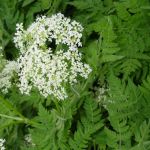| Common Name: |
Garden Myrrh |
| Other Names: |
Sweet Cicely, Sweet Chervil |
| Botanical Name: |
Myrrhis odorata |
| Genus: |
Myrrhis |
| Family: |
Apiaceae |
| Native Location: |
Europe |
| Cultivation: |
Moist, rich soil in sun or shade. |
| Propagation: |
By seed sown when ripe; by division in autumn or spring. Seed may be slow to germinate. May self-sow prolifically in good conditions. |
| Harvest: |
Leaves are picked during the growing season and used fresh or frozen. Roots are lifted in autumn and used fresh, or dried for use in decoctions. Seeds are collected when green and used fresh. |
| Height: |
1-2m (3-6ft) |
| Width: |
60cm-1.2m (2-4ft) |
| Hardiness: |
Z3-7 |
| Parts Used: |
Leaves, roots, seeds |
| Properties: |
A sweet, aromatic, expectorant herb that benefits the digestion. |
| Medicinal Uses: |
Internally for coughs, minor digestive complaints, and anemia. |
| Culinary Uses: |
Leaves are added to salads, soups, stews, and wine cups, and are used as a low-calorie sweetener and flavoring for stewed fruit, yogurt, and whipped cream. Roots are cooked as a vegetable and eaten cold in salads. Unripe seeds are eaten raw in salads. |
| Bibliography: |
The Encyclopedia of Herbs by Deni Bown Copyright © 1995,2001 Dorling Kindersley Limited pp. 285-286 |

